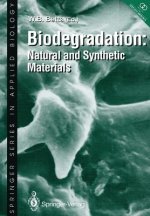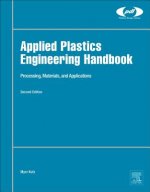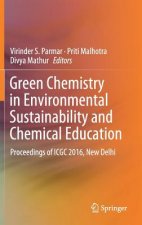
Kód: 20235082
Approaches in Bioremediation
Autor Ram Prasad, Elisabet Aranda
Bioremediation refers to the clean-up of pollution in soil, groundwater, surface water, and air using typically microbiological processes. It uses naturally occurring bacteria and fungi or plants to degrade, transform or detoxify ... celý popis
- Jazyk:
 Angličtina
Angličtina - Väzba: Pevná
- Počet strán: 403
Nakladateľ: Springer Nature Switzerland AG, 2018
- Viac informácií o knihe

252.22 €

Skladom u dodávateľa v malom množstve
Odosielame za 12 - 15 dní
Potrebujete viac kusov?Ak máte záujem o viac kusov, preverte, prosím, najprv dostupnosť titulu na našej zákazníckej podpore.
Pridať medzi želanie
Mohlo by sa vám tiež páčiť
Darujte túto knihu ešte dnes
- Objednajte knihu a vyberte Zaslať ako darček.
- Obratom obdržíte darovací poukaz na knihu, ktorý môžete ihneď odovzdať obdarovanému.
- Knihu zašleme na adresu obdarovaného, o nič sa nestaráte.
Viac informácií o knihe Approaches in Bioremediation
Nákupom získate 623 bodov
 Anotácia knihy
Anotácia knihy
Bioremediation refers to the clean-up of pollution in soil, groundwater, surface water, and air using typically microbiological processes. It uses naturally occurring bacteria and fungi or plants to degrade, transform or detoxify hazardous substances to human health or the environment. For bioremediation to be effective, microorganisms must enzymatically attack the pollutants and convert them to harmless products. As bioremediation can be effective only where environmental conditions permit microbial growth and action, its application often involves the management of ecological factors to allow microbial growth and degradation to continue at a faster rate. Like other technologies, bioremediation has its limitations. Some contaminants, such as chlorinated organic or high aromatic hydrocarbons, are resistant to microbial attack. They are degraded either gradually or not at all, hence, it is not easy to envisage the rates of clean-up for bioremediation implementation. Bioremediation represents a field of great expansion due to the important development of new technologies. Among them, several decades on metagenomics expansion has led to the detection of autochthonous microbiota that plays a key role during transformation. Transcriptomic guides us to know the expression of key genes and proteomics allow the characterization of proteins that conduct specific reactions. In this book we show specific technologies applied in bioremediation of main interest for research in the field, with special attention on fungi, which have been poorly studied microorganisms. Finally, new approaches in the field, such as CRISPR-CAS9, are also discussed. Lastly, it introduces management strategies, such as bioremediation application for managing affected environment and bioremediation approaches. Examples of successful bioremediation applications are illustrated in radionuclide entrapment and retardation, soil stabilization and remediation of polycyclic aromatic hydrocarbons, phenols, plastics or fluorinated compounds. Other emerging bioremediation methods include electro bioremediation, microbe-availed phytoremediation, genetic recombinant technologies in enhancing plants in accumulation of inorganic metals, and metalloids as well as degradation of organic pollutants, protein-metabolic engineering to increase bioremediation efficiency, including nanotechnology applications are also discussed.
 Parametre knihy
Parametre knihy
252.22 €
- Celý názov: Approaches in Bioremediation
- Podnázov: The New Era of Environmental Microbiology and Nanobiotechnology
- Autor: Ram Prasad, Elisabet Aranda
- Jazyk:
 Angličtina
Angličtina - Väzba: Pevná
- Počet strán: 403
- EAN: 9783030023683
- ID: 20235082
- Nakladateľ: Springer Nature Switzerland AG
- Hmotnosť: 793 g
- Rozmery: 235 × 155 × 28 mm
- Dátum vydania: 18. December 2018
Obľúbené z iného súdka
-

Dune
13.10 € -

Haunting Adeline
30.81 € -

Berserk Deluxe Volume 2
52.63 € -

White Nights
3.57 € -24 % -

Powerless
12.48 € -4 % -

Atomic Habits
15.97 € -15 % -

Dune Messiah
9 € -20 % -

Berserk Deluxe Volume 3
52.93 € -

One Day
12.59 € -13 % -

Berserk Deluxe Volume 1
44.43 € -13 % -

Iron Flame
16.27 € -19 % -

Surrounded by Idiots
10.13 € -16 % -

Harry Potter and the Prisoner of Azkaban (Minalima Edition)
27.84 € -32 % -

Gravity Falls Journal 3
22.01 € -

Heaven Official's Blessing: Tian Guan Ci Fu (Novel) Vol. 1
22.01 € -

The Creative Act
24.06 € -

Dune
9.72 € -19 % -

Hunting Adeline
31.84 € -

A Little Life
17.50 € -

Children of Dune
8.80 € -22 % -

Heaven Official's Blessing: Tian Guan Ci Fu (Novel) Vol. 2
25.28 € -

Bungo Stray Dogs, Vol. 8 (light novel)
16.07 € -1 % -

Percy Jackson and the Olympians 5 Book Paperback Boxed Set
47.81 € -

Solo Leveling, Vol. 1
21.50 € -

The Prisoner's Throne
10.64 € -21 % -

Court of Thorns and Roses
9.31 € -22 % -

Cry Baby Coloring Book
10.85 € -4 % -

Fourth Wing
16.68 € -16 % -

Icebreaker
9.41 € -16 % -

Berserk Deluxe Volume 6
47.81 € -6 % -

Avatar, the Last Airbender: The Kyoshi Novels (Box Set)
27.54 € -33 % -

The 48 Laws of Power
26.92 € -1 % -

House of Leaves
23.24 € -4 % -

Twisted Lies
9.72 € -19 % -

Dune Messiah
12.69 € -12 % -

No Longer Human
16.99 € -

48 Laws Of Power
22.62 € -5 % -

Twisted Games
9.41 € -22 % -

Caraval Paperback Boxed Set
39.83 € -8 % -

Solo Leveling, Vol. 2
22.42 € -

Open Circuits
34.40 € -16 % -

Berserk Deluxe Volume 5
51.30 € -

Heaven Official's Blessing: Tian Guan Ci Fu (Novel) Vol. 3
16.78 € -19 % -

Berserk Deluxe Volume 4
46.59 € -9 % -

Court of Mist and Fury
9.31 € -20 % -

SOLO LEVELING V08
22.42 € -

English File Upper Intermediate Multipack A (4th)
22.21 € -

CHAINSAW MAN V14
11.25 € -14 % -

Before the Coffee Gets Cold
10.44 € -20 %
Osobný odber Bratislava a 2642 dalších
Copyright ©2008-24 najlacnejsie-knihy.sk Všetky práva vyhradenéSúkromieCookies







 21 miliónov titulov
21 miliónov titulov Vrátenie do mesiaca
Vrátenie do mesiaca 02/210 210 99 (8-15.30h)
02/210 210 99 (8-15.30h)